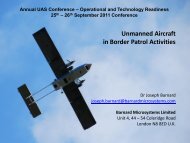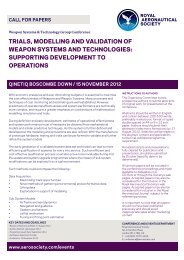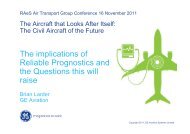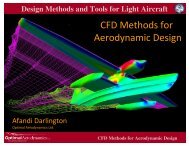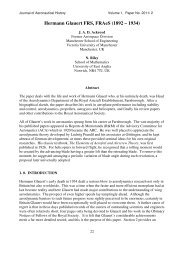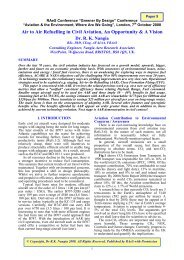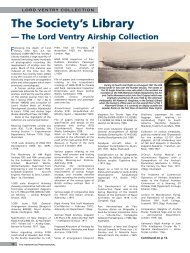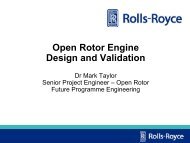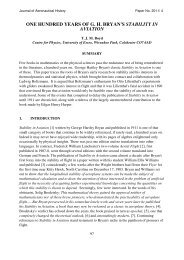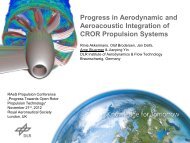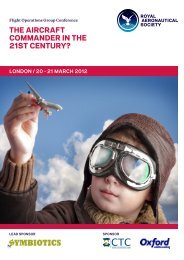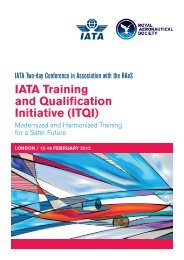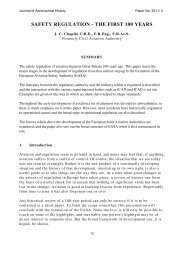Smoke, Fire and Fumes in Transport Aircraft - Royal Aeronautical ...
Smoke, Fire and Fumes in Transport Aircraft - Royal Aeronautical ...
Smoke, Fire and Fumes in Transport Aircraft - Royal Aeronautical ...
You also want an ePaper? Increase the reach of your titles
YUMPU automatically turns print PDFs into web optimized ePapers that Google loves.
APPENDIX 4<br />
FLIGHT OPERATIONS GROUP VIEWS ON AIRCRAFT FIRE EVENTS & CHECKLISTS<br />
Compiled by Capta<strong>in</strong> Ralph Kohn, FRAeS, (BAC & UK CAA Ret)<br />
With thanks to Capta<strong>in</strong> ‘Phil’ H.S. Smith, MRAeS (BA Ret), Capta<strong>in</strong> ‘Chris’ N. White, FRAeS (BA Ret), <strong>and</strong> SFEO Peter G. Richards, IEng,<br />
FRAeS (BA Ret), who are all members of the <strong>Royal</strong> <strong>Aeronautical</strong> Society Flight Operations Group committee, for their help with this Appendix.<br />
SUBJECT MATTER IN THIS APPENDIX BY THE FLIGHT OPERATIONS GROUP IS COMPLEMENTARY TO RECOMMENDATIONS<br />
FOUND IN THE CORE DOCUMENT, WITH WHICH THE 'FOG' IS IN FULL AGREEMENT.<br />
The RAeS Flight Operations Group (FOG) sympathises with the Flight Safety Foundation (FSF) template philosophy presented <strong>in</strong> Appendix 3<br />
of this Specialist Document. In support, Appendix 4 is offered as suggestions for further discussion on the development of the subject <strong>in</strong> the<br />
general context of <strong>Smoke</strong>, <strong>Fire</strong> <strong>and</strong> <strong>Fumes</strong> <strong>in</strong> aircraft, <strong>and</strong> on checklists for use <strong>in</strong> such events.<br />
Some of the recommendations conta<strong>in</strong>ed <strong>in</strong> this Appendix have already been adopted by a few operators but there is a long way yet to go. If<br />
the <strong>in</strong>dustry is to achieve improved conditions that would preclude such events <strong>and</strong> also provide better <strong>in</strong>-flight detection <strong>and</strong> fire fight<strong>in</strong>g<br />
facilities. To illustrate the advocated concept, the sample checklist presentation examples are built round a contemporary aircraft set of drills,<br />
offered <strong>in</strong> a generic ‘consolidated’ format.<br />
Although the ma<strong>in</strong> thrust of this Appendix is the content <strong>and</strong> vital priorities <strong>in</strong> <strong>Smoke</strong>, <strong>Fire</strong> <strong>and</strong> <strong>Fumes</strong> (SFF) control drills, the Appendix is not<br />
limited to the discussion of checklists for use when deal<strong>in</strong>g with smoke, fires <strong>and</strong> noxious fumes events on aircraft <strong>in</strong> flight. The discussion is<br />
broadened to <strong>in</strong>clude the need for positive action under various head<strong>in</strong>gs, from the part of Airl<strong>in</strong>es, Air Traffic Control Services, <strong>Aircraft</strong><br />
Constructors, Manufacturers of fire detection equipment <strong>and</strong> from Providers of fire-fight<strong>in</strong>g materials.<br />
Guidance is also offered for the attention of compilers of Quick Reference Manuals <strong>in</strong> general <strong>and</strong> for checklist drills specific to aircraft smoke,<br />
fire <strong>and</strong> fumes events <strong>in</strong> flight <strong>and</strong> their presentations. In the case of such drills, it is advocated that checklists to be used dur<strong>in</strong>g SFF events<br />
should be self-conta<strong>in</strong>ed all the way down to l<strong>and</strong><strong>in</strong>g the aircraft. Therefore, <strong>in</strong> addition to <strong>and</strong> apart from drills to combat SFF events <strong>in</strong> flight,<br />
Descent, Approach, L<strong>and</strong><strong>in</strong>g <strong>and</strong> after l<strong>and</strong><strong>in</strong>g Evacuation drills are all <strong>in</strong>corporated <strong>in</strong> the preferred all-<strong>in</strong>clusive checklist, so that once it is<br />
started, the flight crew does not need to put drill cards down until the aircraft has been l<strong>and</strong>ed. This Appendix conta<strong>in</strong>s subject matter under<br />
the follow<strong>in</strong>g head<strong>in</strong>gs:<br />
■ <strong>Smoke</strong>, <strong>Fire</strong> <strong>and</strong> <strong>Fumes</strong> Checklists — primary vital considerations<br />
■ Recommendations regard<strong>in</strong>g crew protection <strong>and</strong> fire ext<strong>in</strong>guish<strong>in</strong>g<br />
■ Flight Operations Group Observations also for Consideration<br />
● Airl<strong>in</strong>e Management<br />
● <strong>Smoke</strong> Drill Analysis<br />
● Checklist Methodology<br />
● Air Traffic Control Assistance<br />
■ Manufacturers’ Responsibilities<br />
● Electrical System<br />
● Essential Battery Bus Supply<br />
● <strong>Fire</strong> Detection<br />
● <strong>Aircraft</strong> Thermal Sensors<br />
● <strong>Fumes</strong> from <strong>Aircraft</strong> Systems<br />
■ Safety Equipment <strong>and</strong> Procedures (SEP) Tra<strong>in</strong><strong>in</strong>g<br />
■ The Quick Reference Manual (QRM)<br />
■ Emergency Passenger Evacuation Drill<br />
■ QRM — Emergency & Abnormal Drill <strong>in</strong>dex example<br />
■ Integrated <strong>Smoke</strong>, <strong>Fire</strong> or <strong>Fumes</strong> drill steps based on the Flight Safety Foundation template<br />
■ Examples of Consolidated Checklist Presentations<br />
● Sequentially numbered steps for navigation (Black pr<strong>in</strong>t on Yellow paper)<br />
● Arrows for Navigation (Black pr<strong>in</strong>t on Yellow paper)<br />
● Coloured Arrows for navigation (Black pr<strong>in</strong>t <strong>and</strong> coloured arrows on white paper for better colour contrast)<br />
CHECKLISTS IN GENERAL<br />
Checklists construction will generally conform to guidance offered by the UK CAA <strong>in</strong> CAP 676 (see Appendix 5 of this Specialist Paper).<br />
In parallel with CAP 676 data, it would be extremely useful to be guided by the US NASA publication titled ON THE TYPOGRAPHY OF<br />
FLIGHT-DECK DOCUMENTATION, by Asaf Degani of the San Jose State University Foundation, San Jose, California. This NASA document<br />
was prepared <strong>in</strong> December 1992 for the National Aeronautics <strong>and</strong> Space Adm<strong>in</strong>istration, Ames Research Center, Moffett Field, California<br />
94035-1000, under Contract NCC2-327. It is an excellent <strong>and</strong> exceptionally comprehensive reference source for the optimum presentation of<br />
the pr<strong>in</strong>ted word <strong>in</strong> checklists. The web l<strong>in</strong>k directly to Asaf Degani’s paper is:<br />
http://ti.arc.nasa.gov/people/asaf/pdd/pdf/On the Typography of Flight-Deck Documentation.pdf<br />
It is important to note that the above mentioned paper makes no reference to checklists that need to be used <strong>in</strong> low visibility conditions, such<br />
as for smoke <strong>and</strong> fire drills. Thus, smoke <strong>and</strong> fire checklist developers will need to <strong>in</strong>crease the font size used for text on such checklists, from<br />
that recommended by Asaf Degani.<br />
FEBRUARY 2007 33



